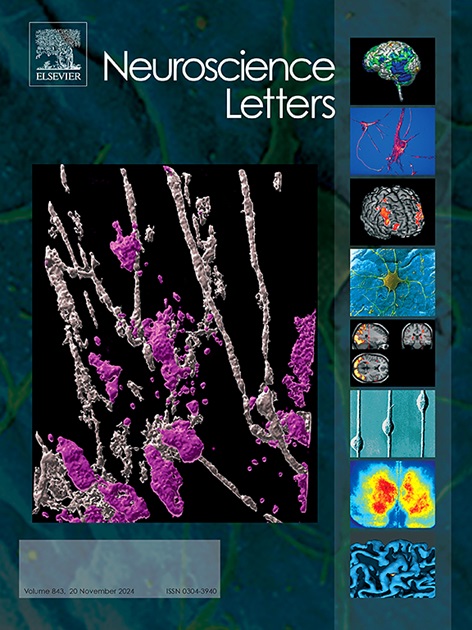Extracellular baskets in inner hair cells and perineuronal nets in auditory nerves: Changes in noise-induced hearing loss rats
IF 2.5
4区 医学
Q3 NEUROSCIENCES
引用次数: 0
Abstract
Background
The extracellular baskets of cochlear inner hair cell (IhC) ribbon synapses have been suggested to regulate synaptic coupling. This study aimed to investigate the expression of components of the extracellular baskets of the IhCs, chondroitin sulfate proteoglycans (CSPGs) and a hyaluronan and proteoglycan link protein 1 (HAPLN1) in the cochlea and auditory nerve. In addition, changes in CSPGs and HAPLN1 in noise-injured cochleae were examined.
Methods
The expression of CSPGs, including aggrecan (ACAN), brevican (BCAN), neurocan (NCAN), and HAPLN1, was evaluated in the cochleae of 2-month-old Sprague–Dawley (SD) rats. The expression of CSPGs and HAPLN1 in cochleae and auditory nerves was compared to that in 3-month-old noise-exposed SD rats during the developmental period. The cochlear immunohistochemistry (IHC) and cochlear whole mount immunofluorescence studies were conducted for ACAN, BCAN, NCAN, and HAPLN1. To examine the large ganglial cells in auditory nerves, IHC was conducted for parvalbumin (PV), glutamate decarboxylase 67 (GAD67), postsynaptic density protein 95 (PSD95), and glial fibrillary acidic protein (GFAP). In situ hybridization was performed for BCAN.
Results
ACAN, BCAN, and HAPLN1 expression was detected in the IhCs and was decreased tendency in noise-injured cochleae. In the spiral ganglial cell (SGC) region, ACAN and NCAN were expressed without the expression of BCAN. In auditory nerves, large ganglionic cells (LGCs) are encased with perineuronal nets (PNNs), which express PV, GAD67, and PSD95. The mRNA expression of BCAN was noted in SGCs and glial cells of auditory nerves.
Conclusions
The extracellular baskets of IhCs revealed the expression of CSPGs and HAPLN1, which was attenuated in noise-exposed cochleae. In auditory nerves, PV-positive LGCs with inhibitory synapses presented PNNs. The protein expression of BCAN was restricted to the extracellular baskets of IhC but not to the SGC region. However, the mRNA expression of BCAN in SGCs was not affected.
听神经内毛细胞外篮和神经周围网:噪声性听力损失大鼠的变化。
背景:耳蜗内毛细胞(IhC)带状突触的细胞外篮被认为调节突触偶联。本研究旨在研究ihc细胞外篮组分、硫酸软骨素蛋白多糖(CSPGs)和透明质酸和蛋白多糖连接蛋白1 (HAPLN1)在耳蜗和听神经中的表达。同时检测噪声损伤耳蜗中CSPGs和HAPLN1的变化。方法:测定2月龄SD大鼠耳蜗中聚集蛋白(ACAN)、布雷维蛋白(BCAN)、神经蛋白(NCAN)、HAPLN1等CSPGs的表达。比较3月龄噪声暴露SD大鼠耳蜗和听神经中CSPGs和HAPLN1的表达。对ACAN、BCAN、NCAN和HAPLN1进行耳蜗免疫组化(IHC)和全耳蜗免疫荧光检测。为检测听神经大神经节细胞,采用免疫组化法检测小白蛋白(PV)、谷氨酸脱羧酶67 (GAD67)、突触后密度蛋白95 (PSD95)和胶质原纤维酸性蛋白(GFAP)。对BCAN进行原位杂交。结果:在ihc中检测到ACAN、BCAN和HAPLN1的表达,在噪声损伤耳蜗中有降低的趋势。在螺旋神经节细胞(SGC)区,ACAN和NCAN均有表达,BCAN无表达。在听神经中,大神经节细胞(LGCs)被表达PV、GAD67和PSD95的神经周网(pnn)包裹。BCAN mRNA在听神经的上颌神经细胞和胶质细胞中表达。结论:IhCs细胞外篮显示CSPGs和HAPLN1的表达,在噪声暴露耳蜗中表达减弱。在听神经中,pv阳性lgc与抑制性突触呈现pnn。BCAN蛋白的表达仅限于IhC的细胞外区,而不局限于SGC区。然而,BCAN在SGCs中的mRNA表达不受影响。
本文章由计算机程序翻译,如有差异,请以英文原文为准。
求助全文
约1分钟内获得全文
求助全文
来源期刊

Neuroscience Letters
医学-神经科学
CiteScore
5.20
自引率
0.00%
发文量
408
审稿时长
50 days
期刊介绍:
Neuroscience Letters is devoted to the rapid publication of short, high-quality papers of interest to the broad community of neuroscientists. Only papers which will make a significant addition to the literature in the field will be published. Papers in all areas of neuroscience - molecular, cellular, developmental, systems, behavioral and cognitive, as well as computational - will be considered for publication. Submission of laboratory investigations that shed light on disease mechanisms is encouraged. Special Issues, edited by Guest Editors to cover new and rapidly-moving areas, will include invited mini-reviews. Occasional mini-reviews in especially timely areas will be considered for publication, without invitation, outside of Special Issues; these un-solicited mini-reviews can be submitted without invitation but must be of very high quality. Clinical studies will also be published if they provide new information about organization or actions of the nervous system, or provide new insights into the neurobiology of disease. NSL does not publish case reports.
 求助内容:
求助内容: 应助结果提醒方式:
应助结果提醒方式:


